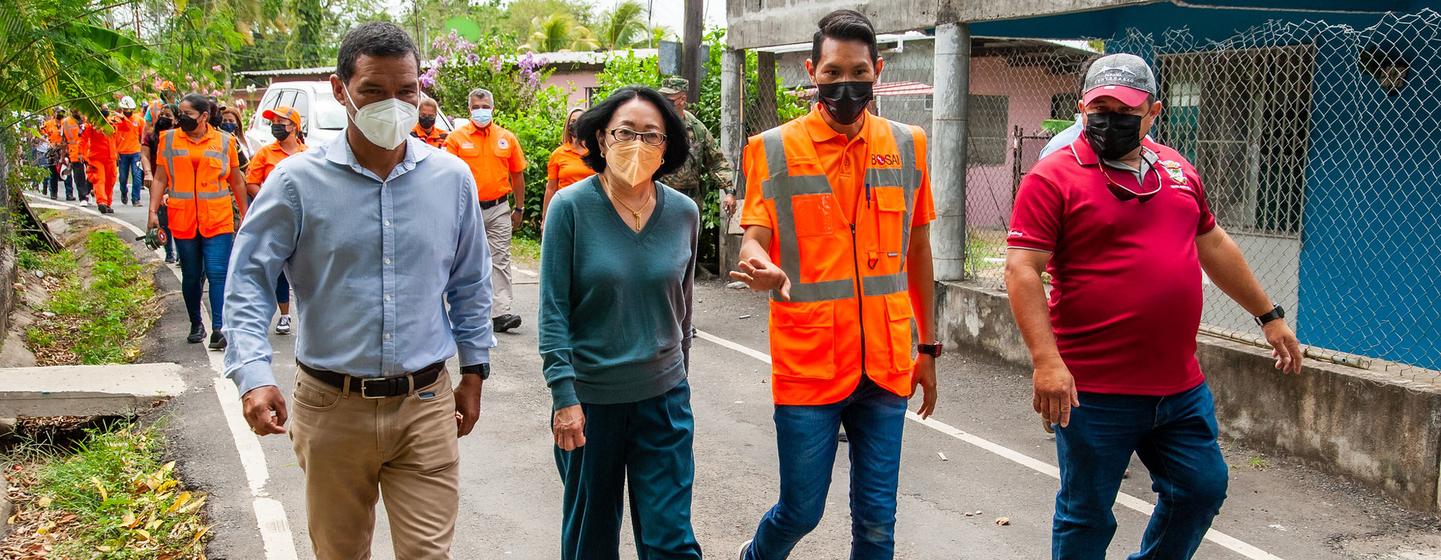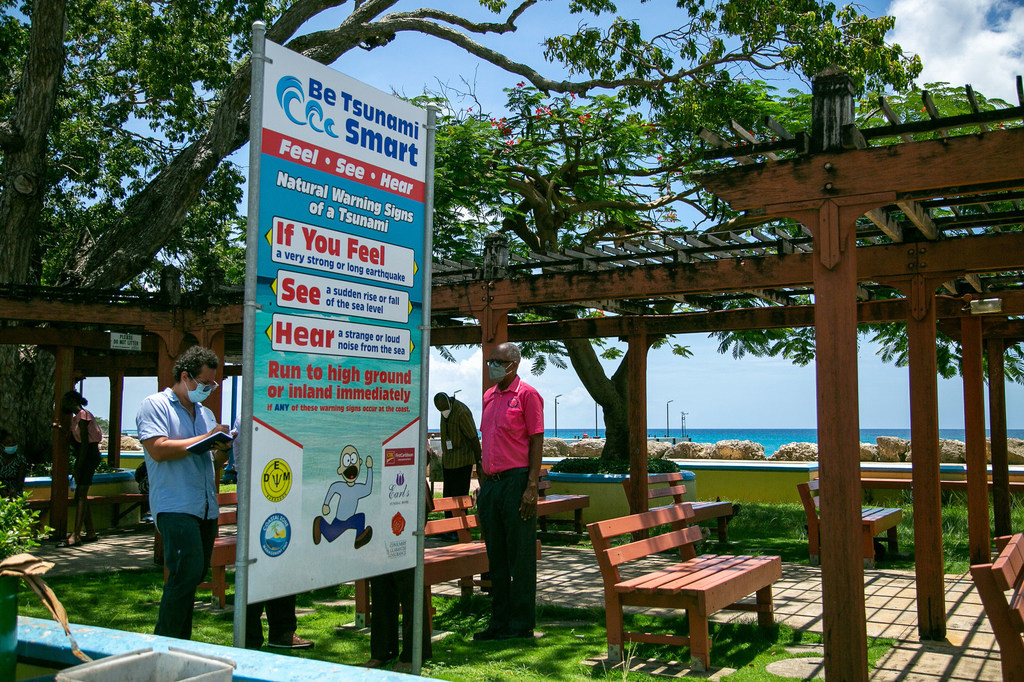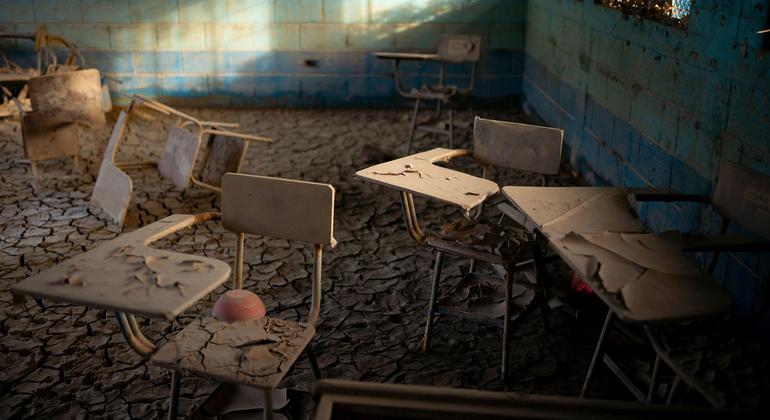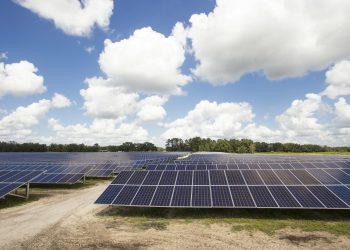From Hurricane Ivan in Jamaica in 2004 to earthquakes in Peru in 2007 and Haiti in 2010, Raul – chief of the regional office for disaster risk reduction – has developed an acute understanding of what the impact of disasters are, and what can be done to avoid or prevent them.
“We continuously face a reality that shows us that disasters, or risks associated with disasters, are more complex than we had ever thought.
For example, we have developed what we call a ‘governance system’, for disaster risk reduction in countries. Agencies are addressing risks, responses, or emergency response mechanisms in the context of natural hazards – climate related, geological-related earthquakes, volcanoes, hurricanes, tornadoes.

Raul Salazar and Mami Mizutori (2nd left), Special Representative of the UN Secretary-General for Disaster Risk Reduction, visited the community of Las Margaritas de Chepo, Panama in 2022.
From pandemic to nuclear meltdown
But, the reality is showing us that this is more complex. For instance, COVID-19, which is a form of the coronavirus that had been around since the early 2000s, was a biological hazard.
When the Sendai Framework was adopted in 2015, it was not talking about natural hazards alone, but rather an understanding in a broader context of what risk means, from human-made disasters to biological hazards – or the case of the 2010 earthquake in Japan and the Fukushima nuclear disaster.
That brought the idea of a central framework, having to address all these hazards and all the different cascade effects that various hazards might have.
‘We build ourselves disasters’
We build ourselves disasters in the way that we choose to orient our development. If we make decisions on development, we ask how are we going to use our land, design for cities, or address the building of public works, hospitals, and schools.
We also have to integrate this into future planning, especially since nearly 32 per cent of the region’s population live in poverty and is likely going to be directly affected by natural hazards.

A hotel in Gele, Haiti, was destroyed after a 7.2 magnitude earthquake struck in 2021.
Making cities resilient
A lot of disaster risk reduction is taking place in cities, where we work with local governments and civil society through a resilience initiative. They self-assess and prepare an action plan for addressing vulnerabilities.
Working recently with some local citizens in Chile, we developed a disaster resilience “scorecard” that has allowed us to identify or better integrate people living with disabilities when planning the city.
Now, we work with local stakeholders in Chile and Costa Rica, applying these mechanisms to save more lives and reduce mortality rates among vulnerable groups.
We learned lessons after the 2010 earthquake in Japan, which showed that persons with disabilities faced deadlier consequences than most.

Partnerships with local government and civil society are key to building resilience.
Grassroots solutions
Working in local communities, we have had good experiences working with grassroots organizations of women, for example, observing rivers during the rainy seasons. There are many women who work activating early-warning mechanisms to alert the people in these areas. The role of local communities is quite direct, with regard to saving lives. Building resilience among them is what we’re trying to achieve.
Sustainably bracing for disaster
It is not possible to think we can achieve sustainable development if the process is not risk informed. Disasters roll back development advances by 10 or 20 years. We have seen that on many, many occasions.
The focus of the Sustainable Development Goals (SDGs) is to leave no one behind and that is related to vulnerable populations on the ground.
Time and time again, disasters disproportionately affect vulnerable populations. Where this happens, we have to understand the risks in a more multisectoral way.

International Atomic Energy Agency (IAEA) experts depart Unit 4 of TEPCO’s Fukushima Daiichi Nuclear Power Station on 17 April 2013.
‘The challenges are many’
The idea of disaster risk reduction before the COVID-19 pandemic had been to reduce the mortality risk. Over the last 20 years, there have been lots of advances in protecting people against natural hazards, many of which are more and more climate related.
In the case of the Americas and the Caribbean, the impact of disasters in terms of economic losses is comparatively higher than other regions of the world. A UNDRR studied showed that the region suffers around 53 per cent of global losses.
One of the challenges is trying to move from a mentality of addressing the impacts of disasters to integrating a perspective of what we can do before hazards happen.
Disaster reduction should be considered a poverty reduction measure because hazards disproportionately affect the poorest and women and girls.
Building bridges
One of the main aspects of this review conference is to assess how far we have gone, and I think that the Americas in the Caribbean region in general has made progress in promoting a multisectoral approach for disaster risk reduction.
But, we need to continue this trend of understanding disasters not only through its impact, but seeing them as an opportunity to do things that go beyond a response approach.
The target is to bring the Sendai Framework to completion in terms of having a society that is not losing lives due to disasters.
What surprises me is the capacity of local communities. We only need to support that capacity to have a better impact. We connect.
We build bridges. That’s what we do.”

Early warning systems, like this public service announcement in Barbados, are critical tools for saving lives and building community resilience ahead of disasters.



